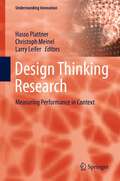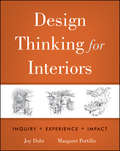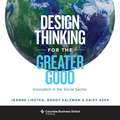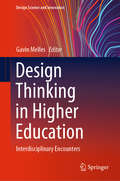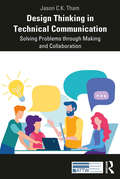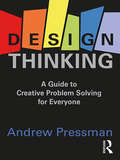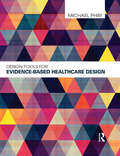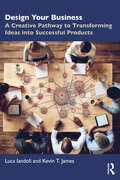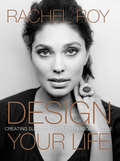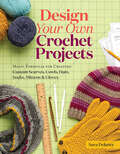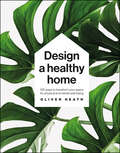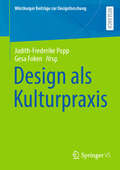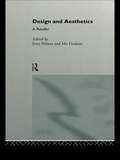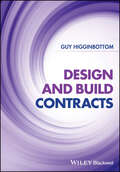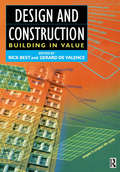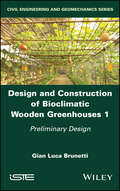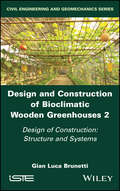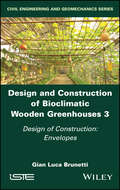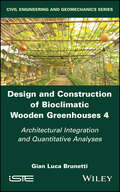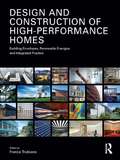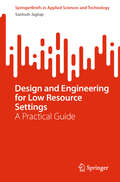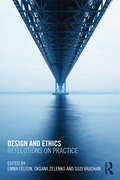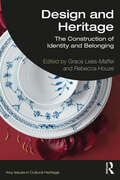- Table View
- List View
Design Thinking Research: Measuring Performance in Context
by Christoph Meinel Hasso Plattner Larry LeiferThis book summarizes the results of the third year in the Design Thinking Research Program, a joint venture of Stanford University in Palo Alto and the Hasso Plattner Institute in Potsdam. Understanding the evolution of innovation, and how to measure the performance of the design thinking teams behind innovations, is the central motivation behind the research work presented in this book. Addressing these fundamental concerns, all of the contributions in this volume report on different approaches and research efforts aimed at obtaining deeper insights into and a better understanding of how design thinking transpires. In highly creative ways, different experiments were conceived and undertaken with this goal in mind, and the results achieved were analyzed and discussed to shed new light on the focus areas. We hope that our readers enjoy this discourse on design thinking and its diverse impacts. Besides looking forward to receiving your critical feedback, we also hope that when reading these reports you too will get caught up in the fun our research teams had in carrying out the work they are based on: understanding innovation and how design thinking fosters it, which was the motivation for all the research work that is reported on in this book.
Design Thinking for Interiors
by Joy H. Dohr Margaret PortilloTake a holistic approach to contemporary interior design. The interior design process is changing. In order to create truly engaging work, designers are developing a deeper and broader understanding of how design theory, research, and existing practice can help them make better decisions. This inquiry provides answers on how design is experienced, and its impact over time. At the same time, the profession is becoming increasingly collaborative. Designers today work closely with other professionals-such as architects, landscape designers, product designers, anthropologists, and business consultants-in new ways, engaging an expanding network of experts in the design process more than ever before. Written by renowned scholars Joy Dohr and Margaret Portillo, the book brings interior design theory and research to life utilizing a narrative inquiry approach that offers highly accessible coverage of the interior design world as it exists today. By looking at real-life stories that demonstrate what makes a memorable design, coupled with photographs and drawings to further illustrate these concepts, this book is a must-read for anyone interested in keeping abreast of interior design in the twenty-first century.
Design Thinking for the Greater Good: Innovation in the Social Sector (Columbia Business School Publishing Ser.)
by Jeanne Liedtka Daisy Azer Randy SalzmanFacing especially wicked problems, social sector organizations are searching for powerful new methods to understand and address them. Design Thinking for the Greater Good goes in depth on both the how of using new tools and the why. As a way to reframe problems, ideate solutions, and iterate toward better answers, design thinking is already well established in the commercial world. Through ten stories of struggles and successes in fields such as health care, education, agriculture, transportation, social services, and security, the authors show how collaborative creativity can shake up even the most entrenched bureaucracies—and provide a practical roadmap for readers to implement these tools.The design thinkers Jeanne Liedtka, Randy Salzman, and Daisy Azer explore how major agencies like the Department of Health and Human Services and the Transportation and Security Administration in the United States, as well as organizations in Canada, Australia, and the United Kingdom, have instituted principles of design thinking. In each case, these groups have used the tools of design thinking to reduce risk, manage change, use resources more effectively, bridge the communication gap between parties, and manage the competing demands of diverse stakeholders. Along the way, they have improved the quality of their products and enhanced the experiences of those they serve. These strategies are accessible to analytical and creative types alike, and their benefits extend throughout an organization. This book will help today's leaders and thinkers implement these practices in their own pursuit of creative solutions that are both innovative and achievable.
Design Thinking in Higher Education: Interdisciplinary Encounters (Design Science and Innovation)
by Gavin MellesThis book addresses the contributions of design thinking to higher education and explores the benefits and challenges of design thinking discourses and practices in interdisciplinary contexts. With a particular focus on Australia, the USA and UK, the book examines the value and drawbacks of employing design thinking in different disciplines and contexts, and also considers its future.
Design Thinking in Technical Communication: Solving Problems through Making and Collaboration (ATTW Series in Technical and Professional Communication)
by Jason ThamThis book explicates the relationships between design thinking, critical making, and socially responsive technical communication. It leverages the recent technology-powered DIY culture called "the Maker Movement" to identify how citizen innovation can inform cutting-edge social innovation that advocates for equitable change and progress on today’s "wicked" problems. After offering a succinct account of the origin and recent history of design thinking, along with its connections to the design paradigm in writing studies, the book analyzes maker culture and its influences on innovation and education through an ethnographic study of three academic makerspaces. It offers opportunities to cultivate a sense of critical changemaking in technical communication students and practitioners, showcasing examples of socially responsive innovation and expert interviews that urge a disciplinary attention to social justice advocacy and an embrace of the design-thinking principle of radical collaboration. The value of design thinking methodologies for teaching and practicing socially responsible technical communication are demonstrated as the author argues for a future in the field that sees its constituents as leaders in radical innovation to solve wicked social problems. This book is essential reading for instructors, students, and practitioners of technical communication, and can be used as a supplemental text for graduate and undergraduate courses in usability and user-centered design and research.
Design Thinking: A Guide to Creative Problem Solving for Everyone
by Andrew PressmanDesign thinking is a powerful process that facilitates understanding and framing of problems, enables creative solutions, and may provide fresh perspectives on our physical and social landscapes. Not just for architects or product developers, design thinking can be applied across many disciplines to solve real-world problems and reconcile dilemmas. It is a tool that may trigger inspiration and the imagination, and lead to innovative ideas that are responsive to the needs and issues of stakeholders. Design Thinking: A Guide to Creative Problem Solving for Everyone will assist in addressing a full spectrum of challenges from the most vexing to the everyday. It renders accessible the creative problem-solving abilities that we all possess by providing a dynamic framework and practical tools for thinking imaginatively and critically. Every aspect of design thinking is explained and analyzed together with insights on navigating through the process. Application of design thinking to help solve myriad problems that are not typically associated with design is illuminated through vignettes drawn from such diverse realms as politics and society, business, health and science, law, and writing. A combination of theory and application makes this volume immediately useful and personally relevant.
Design Tools for Evidence-Based Healthcare Design
by Michael PhiriThe growing movement towards evidence-based healthcare design has largely emphasised a change of culture and attitudes. It has advocated for new ways of working, but until now, it has not focused on equipping healthcare clients and their designers with the practical means to exploit the potential benefits from evidence-based architectural design. Development of indicators and tools that aid designers and users of the built environments in thinking about quality enhances the design process to achieve better outcomes. Importantly, design tools can support managers and designers through end-user involvement and an increased understanding of what patients and staff expect from their healthcare facilities. They can facilitate the creation of patient-centred environments which improve user satisfaction. Design Tools for Evidence-Based Healthcare Design: Discusses the tools that are being used to achieve, design quality and excellence within the context of NHS procurement systems such as PFI, Procure21 and others. Collates information that increases our understanding of these tools, in order to be able to make the best use of them Clarifies where, during the various stages of a building’s life (from inception, design, construction, occupation and re-use), these tools should be used in order to derive the benefits possible from evidence-based design Provides in one place an authoritative reference publication that will act as a memory, a user guide and manual for these design tools Illustrated with case studies from throughout the UK and written by a well-known expert in the field, this book will provide essential reading for anyone involved in healthcare design.
Design With Microclimate: The Secret to Comfortable Outdoor Space
by Robert D. BrownRobert Brown helps us see that a "thermally comfortable microclimate" is the very foundation of well-designed and well-used outdoor places. Brown argues that as we try to minimize human-induced changes to the climate and reduce our dependence on fossil fuels-as some areas become warmer, some cooler, some wetter, and some drier, and all become more expensive to regulate-good microclimate design will become increasingly important. In the future, according to Brown, all designers will need to understand climatic issues and be able to respond to their challenges. Brown describes the effects that climate has on outdoor spaces-using vivid illustrations and examples-while providing practical tools that can be used in everyday design practice. The heart of the book is Brown's own design process, as he provides useful guidelines that lead designers clearly through the complexity of climate data, precedents, site assessment, microclimate modification, communication, design, and evaluation. Brown strikes an ideal balance of technical information, anecdotes, examples, and illustrations to keep the book engaging and accessible. His emphasis throughout is on creating microclimates that attend to the comfort, health, and well-being of people, animals, and plants. Design with Microclimate is a vital resource for students and practitioners in landscape architecture, architecture, planning, and urban design.
Design Your Business: A Creative Pathway to Transforming Ideas into Successful Products
by Luca Iandoli Kevin T. JamesThis actionable and lively guide helps aspiring entrepreneurs to acquire a designer’s mindset to transform ideas into successful products, and designers and technologists to identify entrepeneurial opportunities through a unique mix of product and business development toolkits.Unlike other books focusing either downstream on the launch of a new venture or upstream on ideation and the acquisition of an entrepreneurial mindset, Design Your Business helps innovators to cross the chasm between attractive ideas and actual products, a crucial test in any entrepreneurial endeavor and one which most innovative ideas do not pass. Throughout the book, readers will learn about methods, steps, and resources to unleash their creativity, understand users’ needs, build and test prototypes, and design beautiful products. At the end of this design journey, readers will find an essential business toolkit including business model design, intellectual property protection, funding, and development of effective communication skills that will help them to lay the foundation of a successful venture built around a successful product.This book will become an essential and thought-provoking resource for aspiring entrepreneurs, makers, students of entrepreneurship and new venture creation, and professionals seeking to adopt a design mindset and agile project management in their projects and organizations.Slides and teaching materials based on this book are curated from the authors and available for free at this link: https://elegantdesignthinking.com/category/learning-resources/
Design Your Life: Creating Success Through Personal Style
by Rachel RoyThe internationally renowned designer and entrepreneur helps women look and be the very best version of themselves with this strong, sexy style guide filled with practical and inspirational tips and personal insights gleaned from her own journey in life and business. “As a teen, I’d draw the type of glamorous clothes and accessories I longed for. In retrospect I realize that I was a designing the life I wanted and would one day achieve. ” As a designer, entrepreneur, philanthropist, and working mother, Rachel Roy has a unique perspective on how fashion defines who we are—and who we want to be. Growing up in a low-income neighborhood in California, she envisioned the life she lives today. The head of her own fashion business, she’s a successful, hard-working entrepreneur who believes through style we can help design the life we want to live. Design Your Life is the embodiment of Rachel’s ethos—a style guide every woman, no matter what stage of life she is in, needs to help her define and implement her personal look, motivate her to focus on the person she wants to be and the job she aspires to have, and make choices based on where she wants to go. Rachel offers hands-on tips for developing personal style while staying true to yourself, using and updating what’s in your closest, and adding essential pieces to your wardrobe. Throughout, she shares stories from her own life and the vital role fashion and style has played each step of the way. Elegantly designed and illustrated with more than fifty exclusive color line drawings, filled with her passion, vision, and commitment to empowerment, Design Your Life takes fashion one step further—from looking great to becoming great, from the inside out.
Design Your Own Crochet Projects: Magic Formulas for Creating Custom Scarves, Cowls, Hats, Socks, Mittens & Gloves
by Sara DelaneyYou love to crochet, but you&’re tired of the granny square and other predictable projects. Let celebrated crochet teacher Sara Delaney help you expand your skills while showing you how to create custom-fit wearable accessories. Delaney&’s unique, flexible formulas let crocheters of all levels easily design scarves, cowls, fingerless mitts, mittens, gloves, hats, and socks. With fill-in-the-blank templates and a stitch dictionary, you can use your favorite yarn and stitch pattern, and make accessories that fit perfectly. Delaney offers a starter course in the technique with 18 of her own original patterns, along with the formulas she used to create them. The companion online calculator helps create your customized patterns even more quickly!
Design a Healthy Home: 100 ways to transform your space for physical and mental wellbeing
by Oliver HeathWith indoor air pollution at its worst, and many of us spending more time in our own homes, this interior design guide will help you create calm, social, and comfortable spaces.Let leading sustainability architect, Oliver Heath, give you all the practical solutions you need to transform your space for physical and mental wellbeing.Inside the pages of this home decor book, you&’ll discover how to detoxify your home by making small changes. It includes: • 100 tried and tested, research-based design ideas to support your health and wellbeing in even the smallest of spaces • Stylish, fun, and affordable home design tips based on the latest research in sustainable, biophilic design You're never going to be able to control the environment in the grocery store or your office, but your home is a completely different story. You are in charge of your living space, so why not make it as healthy as can be? Based on the latest evidence and research in wellbeing and biophilic design, this practical guide will show you how to create a restorative and nurturing environment - no matter the size of your space. The ideas and solutions included in this book have been devised with easy implementation in mind. Optimize lighting in your home by using reflective surfaces for a brighter space, follow a ventilation checklist to replenish the air in your home and remove pollutants, or unlock the powers of a tech-free bedroom for a better night's sleep. Whatever your budget and whether you rent or own your property, you can use these creative ideas to make your home a sanctuary.
Design after Capitalism: Transforming Design Today for an Equitable Tomorrow
by Matthew WizinskyHow design can transcend the logics, structures, and subjectivities of capitalism: a framework, theoretical grounding, and practical principles.The designed things, experiences, and symbols that we use to perceive, understand, and perform our everyday lives are much more than just props. They directly shape how we live. In Design after Capitalism, Matthew Wizinsky argues that the world of industrial capitalism that gave birth to modern design has been dramatically transformed. Design today needs to reorient itself toward deliberate transitions of everyday politics, social relations, and economies. Looking at design through the lens of political economy, Wizinsky calls for the field to transcend the logics, structures, and subjectivities of capitalism—to combine design entrepreneurship with social empowerment in order to facilitate new ways of producing those things, symbols, and experiences that make up everyday life. After analyzing the parallel histories of capitalism and design, Wizinsky offers some historical examples of anticapitalist, noncapitalist, and postcapitalist models of design practice. These range from the British Arts and Crafts movement of the nineteenth century to contemporary practices of growing furniture or biotextiles and automated forms of production. Drawing on insights from sociology, philosophy, economics, political science, history, environmental and sustainability studies, and critical theory—fields not usually seen as central to design—he lays out core principles for postcapitalist design; offers strategies for applying these principles to the three layers of project, practice, and discipline; and provides a set of practical guidelines for designers to use as a starting point. The work of postcapitalist design can start today, Wizinsky says—with the next project.
Design als Kulturpraxis (Würzburger Beiträge zur Designforschung)
by Judith-Frederike Popp Gesa FokenDie Beiträge des sechsten Bandes geben einen Einblick in gestalterische Forschungs- und Reflexionsprozesse an der Technischen Hochschule Würzburg-Schweinfurt, der Universität Leiden sowie der Akademie der bildenden Künste Wien. Im thematischen und methodischen Fokus der sechs Beiträge stehen Fragen nach der Einbettung und Anschlussfähigkeit von Designprozessen im Rahmen eines umfassenderen, sozial und politisch situierten Verständnisses von Praktiken der Kulturproduktion. Der Band verdeutlicht den Zusammenhang engagierter und forschender Designhaltungen.
Design and Aesthetics: A Reader
by Mo Dodson Jerry PalmerDesign and Aesthetics: A Reader is a comprehensive student reader on design history and aesthetic theory. It includes contributions from many of the writers whose work has been foundational to these two fields, including classic articles by Raymond Williams and Roger Scruton, and newer articles which provide an overview of current concerns and debates. The role of design in the world today has aroused much controversy. The first half of this book deals with the main arguments which have emerged from contemporary analysis of its role in the communication process. Essays focus on the question of absolute aesthetic standards versus cultural relativism, and the role of objects in cultural and social life. The second part turns to particular areas of design history, ranging from architecture and pottery to the history of dress. These two main sectors are prefaced by contextualising introductions by Jerry Palmer and Mo Dodson.
Design and Build Contracts
by Guy HigginbottomDESIGN AND BUILD CONTRACTS Design and build (D&B) construction procurement relies on a project’s main contractor shouldering the responsibility for creating the design and executing the construction for a project. While the extent of contractor-produced design can vary, this method of construction procurement affords the contractor a greater level of input and responsibility than traditionally procured contracts (where the employer has greater design responsibility). Over the last decade in the UK, it has become clear that D&B contracts are becoming the most popular method for procuring construction projects; often echoing the ways in which contracts for infrastructure and process plant can be procured. Whilst D&B can provide a greater degree of contractor input for producing feasibility and concept designs, then the detailed design to deliver a project, many clients amend standard forms of D&B contracts to alter the contractors’ design input. This can significantly change D&B, deviating from the procedures set out in the standard forms of D&B contract. This book firstly takes the reader through each stage of a project (based upon the RIBA Plan of Work 2020) to provide guidance on how D&B contracts were intended to operate, then secondly, identifying how D&B contracts and their procedures have changed. Readers will find: Outline commentary and guidance on commonly used standard forms of D&B contract, including: JCT Design and Build 2016; FIDIC Conditions of Contract for Plant Design-Build 2017; and NEC4 How each D&B contract is intended to operate during each stage of the RIBA Plan of Work 2020 How the operation of D&B contracts and their procedures are often amended. An ideal resource for contractors, employers, and consultants, as well as those studying construction at university, Design and Build Contracts offers helpful commentary and guidance for how each stage of a D&B engineering or construction project should progress.
Design and Construction (Building In Value Ser.)
by Rick Best Gerard De ValenceThe design and construction of buildings is a lengthy and expensive process, and those who commission buildings are continually looking for ways to improve the efficiency of the process. In this book, the second in the Building in Value series, a broad range of topics related to the processes of design and construction are explored by an international group of experts. The overall aim of the book is to look at ways that clients can improve the value for money outcomes of their decisions to construct buildings. The book is aimed at students studying in many areas related to the construction industry including architecture, construction management, civil engineering and quantity surveying, and should also be of interest to many in the industry including project managers, property developers, building contractors and cost engineers.
Design and Construction of Bioclimatic Wooden Greenhouses, Volume 1: Preliminary Design
by Gian Luca BrunettiDesign and Construction of Bioclimatic Wooden Greenhouses, Volume 1: Preliminary Design
Design and Construction of Bioclimatic Wooden Greenhouses, Volume 2: Design of Construction: Structure and Systems
by Gian Luca BrunettiDesign and Construction of Bioclimatic Wooden Greenhouses, Volume 2: Design of Construction: Structure and Systems
Design and Construction of Bioclimatic Wooden Greenhouses, Volume 3: Design of Construction: Envelopes
by Gian Luca BrunettiDesign and Construction of Bioclimatic Wooden Greenhouses, Volume 3: Design of Construction: Envelopes
Design and Construction of Bioclimatic Wooden Greenhouses, Volume 4: Architectural Integration and Quantitative Analyses
by Gian Luca BrunettiDesign and Construction of Bioclimatic Wooden Greenhouses, Volume 4: Architectural Integration and Quantitative Analyses
Design and Construction of High-Performance Homes: Building Envelopes, Renewable Energies and Integrated Practice
by Franca TrubianoBoth professionals and students are increasingly committed to achieving high-performance metrics in the design, construction and operation of residential buildings. This book responds to this demand by offering a comprehensive guide which features: architectural innovations in building skin technologies which make lighter more transparent buildings high performing; energy-free architectural design principles and advances in building-integrated photovoltaics; essential engineering principles, controls and approaches to simulation for achieving net zero; the advantages of integrated design in residential construction and the challenges and opportunities it engenders; detailed case studies of innovative homes which have incorporated low-energy design solutions, new materials, alternative building assemblies, digital fabrication, integrated engineering systems and operational controls. Divided into four parts, the book discusses the requisite AEC (Architecture, Engineering and Construction) knowledge needed when building a high-performance home. It also communicates this information across four case studies, which provide the reader with a thorough overview of all aspects to be considered in the design and construction of sustainable homes. With contributions from experts in the field, the book provides a well-rounded and multi-faceted approach. This book is essential reading for students and professionals in design, architecture, engineering (civil, mechanical and electrical), construction and energy management.
Design and Engineering for Low Resource Settings: A Practical Guide (SpringerBriefs in Applied Sciences and Technology)
by Santosh JagtapThis book provides an integrated and practical methodology aimed at designing, developing, and implementing holistic solutions for the betterment of people living in low resource settings within developing nations. These people confront a multitude of challenges at individual, institutional, economic, and technological levels. Consequently, integrated solutions are necessary to satisfy their unmet or underserved needs effectively. Using a comprehensive approach, this book offers a systematic methodology for designing such integrated solutions, supplemented by case studies and actionable guidelines. Outstanding features of the book include: An integrated methodology and guidelines for designing, developing, and implementing holistic solutions to support development of resource-constrained societies. The guidelines cover phases in the design process such as understanding context and needs, concept exploration and detailing, and implementation. Case studies illustrate each guideline. Visual illustrations for easy understanding of the guidelines. Actionable methods and strategies for applying the integrated methodology and guidelines in projects. Practitioners, students, and researchers, interested in the sustainable development of low resource settings, will find this book motivating and practical.
Design and Ethics: Reflections on Practice
by Emma Felton Oksana Zelenko Suzi VaughanThe value of design for contributing to environmental solutions and a sustainable future is increasingly recognised. It spans many spheres of everyday life, and the ethical dimension of design practice that considers environmental, social and economic sustainability is compelling. Approaches to design recognise design as a practice that can transform human experience and understanding, expanding its role beyond stylistic enhancement. The traditional roles of design, designer and designed object are therefore redefined through new understanding of the relationship between the material and immaterial aspects of design where the design product and the design process are embodiments of ideas, values and beliefs. This multi-disciplinary approach considers how to create design which is at once aesthetically pleasing and also ethically considered, with contributions from fields as diverse as architecture, fashion, urban design and philosophy. The authors also address how to teach design based subjects while instilling a desire in the student to develop ethical work practices, both inside and outside the studio.
Design and Heritage: The Construction of Identity and Belonging (Key Issues in Cultural Heritage)
by Grace Lees-Maffei Rebecca HouzeDesign and Heritage provides the first extended study of heritage from the point of view of design history. Exploring the material objects and spaces that contribute to our experience of heritage, the volume also examines the processes and practices that shape them. Bringing together 18 case studies, written by authors from the United States, the United Kingdom, Canada, Brazil, Norway, India, South Africa, Australia and New Zealand, the book questions how design functions to produce heritage. Including provocative case studies of objects that reinterpret visual symbols of cultural identity and buildings and monuments that evoke feelings of national pride and historical memory, as well as landscapes embedded with trauma, contributors consider how we can work to develop adequate shared conceptual models of heritage and apply them to design and its histories. Exploring the distinction between tangible and intangible heritages, the chapters consider what these categories mean for design history and heritage. Finally, the book questions whether it might be possible to promote a truly equitable understanding of heritage that illuminates the social, cultural and economic roles of design. Design and Heritage demonstrates that design historical methods of inquiry contribute significantly to critical heritage studies. Academics, researchers and students engaged in the study of heritage, design history, material culture, folklore, art history, architectural history and social and cultural history will find much to interest them within the pages of the book.
